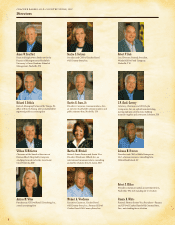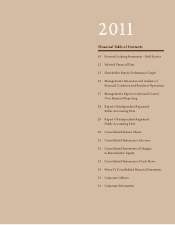Cracker Barrel 2011 Annual Report Download - page 20
Download and view the complete annual report
Please find page 20 of the 2011 Cracker Barrel annual report below. You can navigate through the pages in the report by either clicking on the pages listed below, or by using the keyword search tool below to find specific information within the annual report.
decrease from 2009 to 2010 resulted primarily from lower
average debt outstanding.
Provision for Income Taxes
Provision for income taxes as a percent of income before
income taxes was 26.3%, 26.3% and 26.8% in 2011, 2010 and
2009, respectively. Our effective tax rate remained flat at
2011 compared to 2010. e decrease in the effective tax rate
from 2009 to 2010 reflected a net reduction in our liability
for uncertain tax positions of $2,134 in 2010 compared to
$389 in 2009 and higher employer tax credits on an absolute
dollar basis mostly offset by the effect on our tax rate from
the increase in pretax income.
LIQUIDITY AND CAPITAL RESOURCES
e following table presents a summary of our cash flows for
the last three years:
2011 2010 2009
Net cash provided by
operating activities
of continuing operations $138,212 $212,106 $164,171
Net cash used in investing
activities of continuing
operations(69,489) (69,626) (9,087)
Net cash used in financing
activities of continuing
operations(64,149) (106,389) (155,406)
Net cash used in operating
activities of
discontinued operations — — (47)
Net increase (decrease) in
cash and cash equivalents $4,574 $36,091 $(369)
Our primary sources of liquidity are cash generated from
our operations and our borrowing capacity under our
revolving credit facility. Our internally generated cash, along
with cash on hand at July 30, 2010, our borrowings under our
revolving credit facility and proceeds from exercises of share-
based compensation awards, were sufficient to finance all of our
growth, share repurchases, dividend payments, working
capital needs and other cash payment obligations in 2011.
We believe that cash at July 29, 2011, along with cash
generated from our operating activities, the borrowing capacity
under our revolving credit facility and proceeds from exercises
of share-based compensation awards will be sufficient to finance
our continuing operations, our continuing expansion plans,
our principal payments on our debt, our share repurchase plans
and our expected dividend payments for at least the next twelve
months and thereaer for the foreseeable future.
Cash Generated from Operations
Our cash generated from operating activities was $138,212,
$212,106 and $164,171 in 2011, 2010 and 2009, respectively.
e decrease in net cash flow provided by operating activities
from 2010 to 2011 reflected a decrease in accounts payable,
payments for estimated income taxes and higher annual
bonus payments made in 2011 for the prior year’s performance
partially offset by the change in retail inventories. e
decrease in accounts payable reflected the results of conversion
to more electronic payment methods and lower accounts
payable related to retail inventory. e change in retail
inventories was primarily related to the timing of seasonal
inventory purchases. e increase in net cash flow provided by
operating activities from 2009 to 2010 reflected higher net
income, increase in accounts payable, the timing of payments
for estimated income taxes, higher incentive compensation
accruals and an increase in the sales of our gi cards partially
offset by the change in retail inventories. e increase in
incentive compensation accruals in 2010 reflected beer
performance against financial objectives in 2010 as compared
to the prior year. e increase in accounts payable from
2009 to 2010 resulted from more effective vendor terms
management and improvements to disbursement cycles.
e change in retail inventories was primarily related to the
timing of seasonal inventory purchases.
Borrowing Capacity and Debt Covenants
On July 9, 2011, we entered into a five-year $750,000 credit
facility (the “2011 Credit Facility”) consisting of a $250,000
term loan (aggregate outstanding at July 29, 2011 was
$231,250) and a $500,000 revolving credit facility (“the
2011 Revolving Credit Facility”). e 2011 Credit Facility
replaced term loans totaling $575,000 and a $165,000
revolving credit facility. e decrease in the term loan portion
of the 2011 Credit Facility and the increase in the 2011
Revolving Credit Facility provide us with increased flexibility
in our capital structure.
During 2011, 2010 and 2009, we made $18,750, $57,856
and $130,988, respectively, in optional principal prepay-
ments under our term loan facilities. At July 29, 2011, we had
$318,750 of outstanding borrowings under the 2011
18
B)LQDQFLDOLQGG 30
























